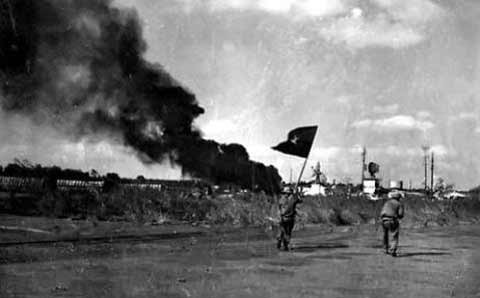(VOVworld) – Analyzing the Great Spring Victory of 1975, war veterans, experts, and historians have attributed the victory to Vietnam’s ability to grasp opportunities, make quick decisions, effectively cooperate men and materials, and mobilize a people’s war.

The Vietnam People's Army attacked Buon Me Thuat airport during the Central Highlands campaign in 1975 (photo: Museum of history) |
Based on the situation in Vietnam’s southern region following the Paris Accord of 1973 and sufficient preparations for big battles, the Vietnam People’s Army and local militias launched the Central Highlands campaign on March 4, 1975, which opened the General Offensive and Uprising of Spring 1975. The Politburo decided that it was time to quickly liberate the south before the onset of the rainy season.
Grasping strategic opportunities
After the victory of the Central Highlands campaign, the Hue-Da Nang campaign in late March, 1975, was also successful. Army units and militias clearly understood the Politburo’s order to grasp strategic opportunities and strike quickly, aggressively, and unpredictably to achieve certain victory. Deputy Chief of the General Staff of the Vietnam People’s Army, Lieutenant-general Vo Van Tuan, says: “The victory was due to wise and prompt decisions by the Party, the Politburo, and the General Staff. General Vo Nguyen Giap’s secret telegram said “faster, and faster, aggressive, more aggressive”. It was an order to advance.”
The Vietnamese army and people had laid a firm foundation for the campaign and built up strong army corps and local militias. They became committed to turning will into action by mobilizing all support from the north and all forces on the southern front line. Former Director of the Institute of Party History Nguyen Trong Phuc said: "Victory resulted from the combined power of the military operation and the people’s uprising. It was truly a Vietnam people’s war. The people’s war rallied the power of politics, the military, diplomacy, local manpower, and support from the north."
The art of promoting combined power
The ardent desire for peace, independence, and national reunification of all the people coalesced into a national united front to win the General Offensive and Uprising of spring 1975. After the 12-day defense of Hanoi, dubbed “Dien Bien Phu in the air”, which forced the US to sign the Paris Accord of 1973 and withdraw troops from southern Vietnam, the north continued to support the struggle in the south.
Under fierce bombardment, the Truong Son trail supplied soldiers, fuel, and weapons to the southern front line. Vietnam won battle after battle and eventually, the final General Offensive and Uprising to liberate the south. War veteran professor Dinh Xuan Dung said: "Our adversary thought we had insufficient forces to liberate the south. But our forces, including hundreds of tanks and armored vehicles, and many battalions, conveyed from the Central Highlands, Quang Tri province, and the southern Mekong delta to quickly liberate the south."
The Vietnam People’s Army and local militias effectively cooperated to intensify their strength. The General Offensive and Uprising of spring 1975 to liberate southern Vietnam took 55 days. Its success was due to the Communist Party of Vietnam’s wise leadership in organizing forces, mobilizing a people’s war, seizing opportunities, and being determined to win.